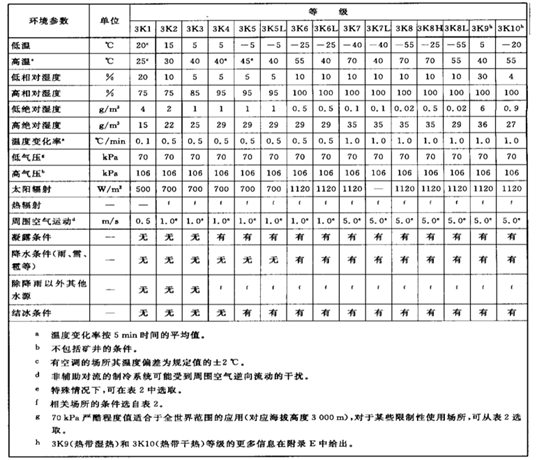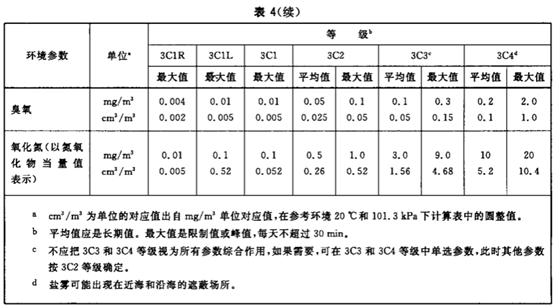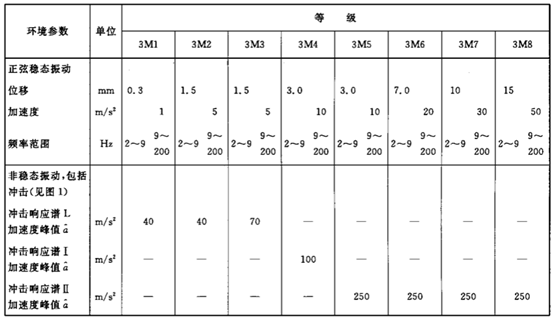4.3.3 GB/T4798.3 Environmental conditions for the application of electrical and electronic products - Part 3: Fixed use in places with climate protection
This part is GB/T4798.3 2007, modified to adopt IEC60721-3-3:2002 'Classification of Environmental Conditions - Part 3: Classification of Environmental Parameter Groups and Their Severity Levels - Section 3: Fixed Use in Climate Protected Places' (English version).
This section applies to the classification and severity level of environmental parameter groups encountered in normal use (including installation, shutdown, and maintenance) of products used on the ground for fixed purposes.
This section includes the installation of products in temporary or permanent fixed use climate-protected areas, such as land, seaside enclosed and sheltered areas. Excluding products on and inside the vehicle.
This section specifies environmental conditions that only affect product performance. Only such environmental conditions are considered. Without describing the impact of these environmental conditions on the product.
Do not consider environmental conditions caused by fires, explosions, and ionizing radiation, as well as environmental conditions caused by other unexpected accidents. In special circumstances, the probability of these factors occurring should be considered.
Excluding the microclimate inside the product.
The fixed use, carrying and non fixed use, vehicle and ship use, storage and transportation conditions, as well as the microclimate inside the product in places without climate protection, are specified in other parts of GB/T4798.
A limited number of environmental condition levels include a wide range of applications. Users of this section should choose the lowest level that can cover the expected usage conditions.
1. General requirements
This part is used simultaneously with GB/T4798.10; The terms and definitions established in GB/T11804 are applicable to this part.
During installation, there is usually a shutdown, and standard users should distinguish this type of situation from the product's usage time zone. Unless otherwise specified, other levels should be selected.
The probability of exceeding the prescribed severity level is very low. All specified values are either maximum or limit values. These values may reach, but they will not appear for long. Over a period of time, the frequency of severity varies depending on the location. This section does not consider the frequency of such occurrences, but the frequency of any environmental parameters should be considered. If necessary, additional provisions will be made. The frequency and period of occurrence are specified in GB/T4798.10.
It should be noted that the simultaneous occurrence of several specified environmental parameters may increase the impact on the product. This is particularly evident when high relative humidity occurs simultaneously under biological, chemically active, and mechanically active conditions.
The environmental conditions of a certain location may be affected by other factors, such as heat dissipation sources, special process conditions, etc.
The measurement of environmental conditions at a certain location should be carried out at selected points around the product.
It should be acknowledged that there are extreme and special environmental conditions. Products used in such special environments shall be determined through consultation between the supply and demand parties.
2. Classification of environmental parameter groups and their severity level
Tables 1-6 and 8-12 specify a series of environmental condition levels:
——Climatic conditions (K);
——Special climatic conditions (Z);
——Biological conditions (B);
——Chemical active substance condition (C);
——Mechanical active substance conditions (S);
——Mechanical conditions (M);
——Initial ignition conditions (T, P, F, V, H).
The possible combinations of environmental conditions encountered by the product constitute a series of categories, representing the actual application situation worldwide, depending on outdoor climate, building structure, installation, process conditions, etc.
Higher levels of digital environmental conditions typically include lower levels of digital environmental conditions.
Some parameters cannot quantitatively specify the severity level.
For a given location and product, a complete set of grade combinations should be selected, such as 3K2/3Z1/3Z4/3B1/3C2/3S1/3M4 and 3T1/3P3/3F2/3V2/3H3.
Appendix A explains the basis for environmental condition levels, describes the usage sites included in each level, and provides information on the selection of environmental parameters and their severity.
Appendix B provides a graph of the relationship between temperature, relative humidity, and absolute humidity in the climate levels specified in Table 1.
Appendix C provides two examples of environmental parameter classification applications.
2.1 Climatic conditions
The climatic conditions specified in 3K1 to 3K8 represent the environmental conditions of places with climate protection, which are long-term environmental conditions experienced worldwide, taking into account all parameters that can affect them, such as external (outdoor) climatic conditions, building structure types, temperature/humidity control systems, and internal conditions (such as heat dissipation of installed equipment, human activities, etc.). These conditions take into account all normal situations, but do not include special situations such as air conditioning system malfunctions.
3K9 and 3K10 specify the tropical climate conditions, which are explained in Appendix E.
When selecting an appropriate level, it should be noted that the climate conditions inside the building depend on external (outdoor) conditions, especially temperature, solar radiation, and the type of building structure. Walls with good insulation or high heat capacity can continuously balance the temperature difference between day and night or even longer. Walls with poor insulation do not have this effect, but instead amplify the temperature difference due to daytime solar radiation and nighttime building heat dissipation. The effect of solar radiation increases due to the heat collection effect and greenhouse effect.
The actual relationship between temperature and humidity cannot be expressed solely in terms of severity. Therefore, Appendix B provides a climate map.
2.2 Special climatic conditions
Various severe levels of thermal radiation, surrounding air movement, other sources of water other than rainwater, high temperatures, and low pressure can all accompany other climatic conditions, therefore Table 2 specifies these special environmental conditions. In this situation, the simultaneous occurrence of several events increases the severity, and considering these can lead to unnecessary design.
2.3 Biological conditions
These conditions cannot be quantitatively specified, and the special parameters in Table 3 are typical but not necessarily complete.
2.4 Chemical active substances
The pollution in nature mainly comes from industrial activities, motor vehicles, and emissions from heating systems. The more severe chemical pollution comes from ocean salt mist. These pollutants may affect the materials and performance of the product.
The indicators given in the classification are based on years of investigation. Due to the direct impact of high concentration in the short term, the material will be more severely damaged and even unable to regenerate, so the maximum values are given in the table. The average value is provided as it plays an important role in the long-term impact on the internal components of the product.
In fact, all pollutants in this section cannot occur simultaneously. Even if these pollutants appear simultaneously, the possibility of their concentration uniformly increasing at the same time is not significant. In different places, there is usually only one pollutant with a higher concentration. The specified value of 3C1 level corresponds to rural and low industrial activity areas. The specified value of 3C2 level corresponds to the urban area. Therefore, the severity of these two levels meets the comprehensive effect of all parameters. The severity level of 3C3 and 3C4 cannot be considered to meet the comprehensive effect of all parameters, otherwise it will lead to uneconomical over design. For levels 3C3 and 3C4, only a single parameter corresponding to the place of use can be selected. If a single parameter in the 3C3 and 3C4 levels is selected, and other parameters not mentioned can be selected as values in the 3C2 level.
Note: Chemically active liquids and chemically active solids other than sea salt are not considered in this section.
2.5 Mechanically active substances
Sinusoidal vibration is classified according to the amplitude of acceleration and displacement, corresponding to different frequency ranges.
This section does not consider random vibration and will only be considered when there is sufficient data.
The non-stationary vibration including impact is classified according to the first level non damping maximum impact response spectrum, as shown in GB/T4796.
2.7 Initial state conditions of fire
The fire environmental conditions can be found in IEC60721-2-8, which are related to the initial state of indoor fires and serve as the basis for selecting environmental parameters and their severity levels. The main parameters are as follows:
a) Fire conditions before flashover:
——Flashover time (see Table 8);
——The thermal energy of various surfaces and objects within the site;
——The temperature of the upper gas in the site;
——The heat release efficiency (RHR) is related to the heat release rate that causes flashover in the workplace (RHRf0), therefore, RHR/RHRf0
Ratio representation (see Table 9).
b) Fire conditions after flashover:
The highest gas temperature occurs during the heat dissipation stage of the fire site (see Table 10).
c) Smoke and chemically active substance conditions:
——Optical density (see Table 11);
——Hydrogen chloride concentration (see Table 12).
The listed parameters are used to illustrate the environmental fire conditions. Some parameters specify the characteristics of encountering a fire. The levels in Table 9 represent the reaction of materials and products to fire under pre flashover fire conditions, while the parameters corresponding to the levels in Table 10 are the fire properties and load carrying capacity after flashover fire conditions, as well as the fire resistance of discrete structures, windows, ventilation systems, etc. Although there are no specific characteristics for direct fire exposure. The heat release rate parameters in Table 9 and the time parameters in Table 8 are extremely important for the risk of flashover, as well as for the safe escape of people from fires in the event of flashover. The gas temperature parameters in Table 9, as well as those in Tables 11 and 12, are all characteristics of encountering fires, and are crucial for optical instrument detection, evacuation, and refuge in safe areas in case of fire. The concentration of hydrogen chloride generated after electrical products come into contact with fire is extremely important for evaluating the subsequent corrosion of the product.
3. Environmental condition level combination
The environmental condition group is composed of a series of possible combinations of product environmental conditions. The number and flexibility of combinations are very large. In fact, this flexibility is not always beneficial, for example, when discussing environmental conditions files in different aspects, there will inevitably be slight differences in interference.
In general, to avoid this possibility, select the standard combination of severity levels from Table 7. For a given location and product, you can refer to this section, such as selecting IE32. Only when the standard does not include the required combination of severity levels, can the combination of levels be selected according to each level in this section. If the severity of certain parameters is different from the level combination specified in this section, the following phrase should be added: 'But... (parameter)... (severity and unit)', such as IE32 but sand is 30mg/m3.
Appendix D provides a description of the combined environmental conditions.
Table 1 Climatic Condition Levels

Table 2 Special Climate Condition Levels
环境参数 | 等级 | 单位 | 特殊条件 |
高温 | 3Z11 | ℃ | 55 |
低气压c | 3Z12 | kPa | 84 |
热辐射 | 3Z1 | - | 可忽略 |
3Z2 | - | 有热辐射条件,例如室内加热系统附近 |
3Z3 | - | 有热辐射条件,例如室内加热系统或工业炉、商业炉附近 |
周围空气运动b | 3Z4 | m/s | 5 |
3Z5 | m/s | 10 |
3Z6 | m/s | 30 |
降雨以外的其他水源c | 3Z7 | - | 滴水条件 |
3Z8 | - | 滴水条件 |
3Z9 | - | 滴水条件 |
3Z10 | - | 滴水条件 |
a非辅助对流制冷系统可能受到周围空气逆向流动的干扰。 b不包括水下条件。 c 3z12等级对应约1400m海拔高度。 |
表3 生物条件等级
环境参数 | 单位 | 等级 |
3B1 | 3B2 | 3B3 |
植物 | - | - | 霉菌、 真菌等 | 霉菌、 真菌等 |
动物 | - | - | 啮齿动物和其他危害产品的动物,白蚁除外 | 啮齿动物或其他危害产品的动物,包括白蚁 |
Table 4 Condition Levels of Chemical Active Substances


Table 5 Condition Levels of Mechanically Active Substances
环境参数 | 单位 | 等级 |
3S1 | 3S2 | 3S3 | 3S4 |
沙 | mg/m3 | - | 30 | 300 | 3000 |
尘(飘浮) | mg/m3 | 0.01 | 0.2 | 0.4 | 4.0 |
尘(沉积) | mg/(m2*h) | 0.4 | 1.5 | 15 | 40 |
Table 6 Mechanical Condition Levels

环境条件 | 等级组合 |
IE31 | IE32 | IE33 | IE34 | IE35 | IE36 | IE37 |
气候 特殊气候 生物 化学活性物质 机械活性物质 机械 | 3K2 - - - 3B1 3C1 3S1 3M1 | 3K3 3Z2 3Z4 - 3B1 3C1 3S1 3M1 | 3K3 3Z2 3Z4 - 3B1 3C2 3S2 3M2 | 3K4 3Z2 3Z4 3Z8 3B2 3C2 3S2 3M2 | 3K5 3Z2 3Z4 3Z8 3B2 3C2 3S3 3M3 | 3K6 3Z2 3Z5 3Z8 3B2 3C2 3S3 3M3 | 3K7 3Z2 3Z5 3Z8 3B2 3C2 3S3 3M3 |
表8 闪络时间
环境参数 | 单位 | 等级 |
3T1 | 3T2 | 3T3 | 3T4 | 3T5 |
闪络时间 | min | 20 | 12 | 8 | 4 | 2 |
表9 闪络前的热条件
环境参数 | 单位 | 等级 |
3P1 | 3P2 | 3P3 | 3P4 | 3P5 |
材料和产品承受的热通量 | Kw/m2 | 10 | 20 | 30 | 50 | 75 |
气体温度(气体上层) | ℃ | 150 | 300 | 400 | 500 | 600 |
热释放率与导致闪络的热释放率之比 | - | 0.2 | 0.4 | 0.6 | 0.8 | 1 |
表10 闪络后的热条件
环境参数 | 单位 | 等级 |
3F1 | 3F2 | 3F3 | 3F4 |
气体最高温度 | ℃ | 600 | 800 | 1000 | 1200 |
热态持续时问 | min | 10 | 20 | 30 | 40 |
Table 11 Visibility conditions through smoke
环境参数 | 单位 | 等级 |
3V1 | 3V2 | 3V3 | 3V4 | 3V5 |
光密度 | l/m | 0.02 | 0.05 | 0.2 | 0.5 | 1 |
注: 见IEC60721-2-8图13的说明。 |
Table 12 Conditions for Chemical Active Substances
环境参数 | 单位 | 等级 |
3H1 | 3H2 | 3H3 | 3H4 |
氯化氢浓度 | mg/m3 | 200 | 500 | 1000 | 4000 |
持续时间 | min | 10 | 10 | 10 | 10 |

Example of Half Sine Pulse Duration
Spectrum L: duration 22ms;
Spectrum I: duration of 11ms;
Spectrum II: Duration 6ms.
Figure 1 Typical Impact Response Spectrum
(First level maximum impact response spectrum)